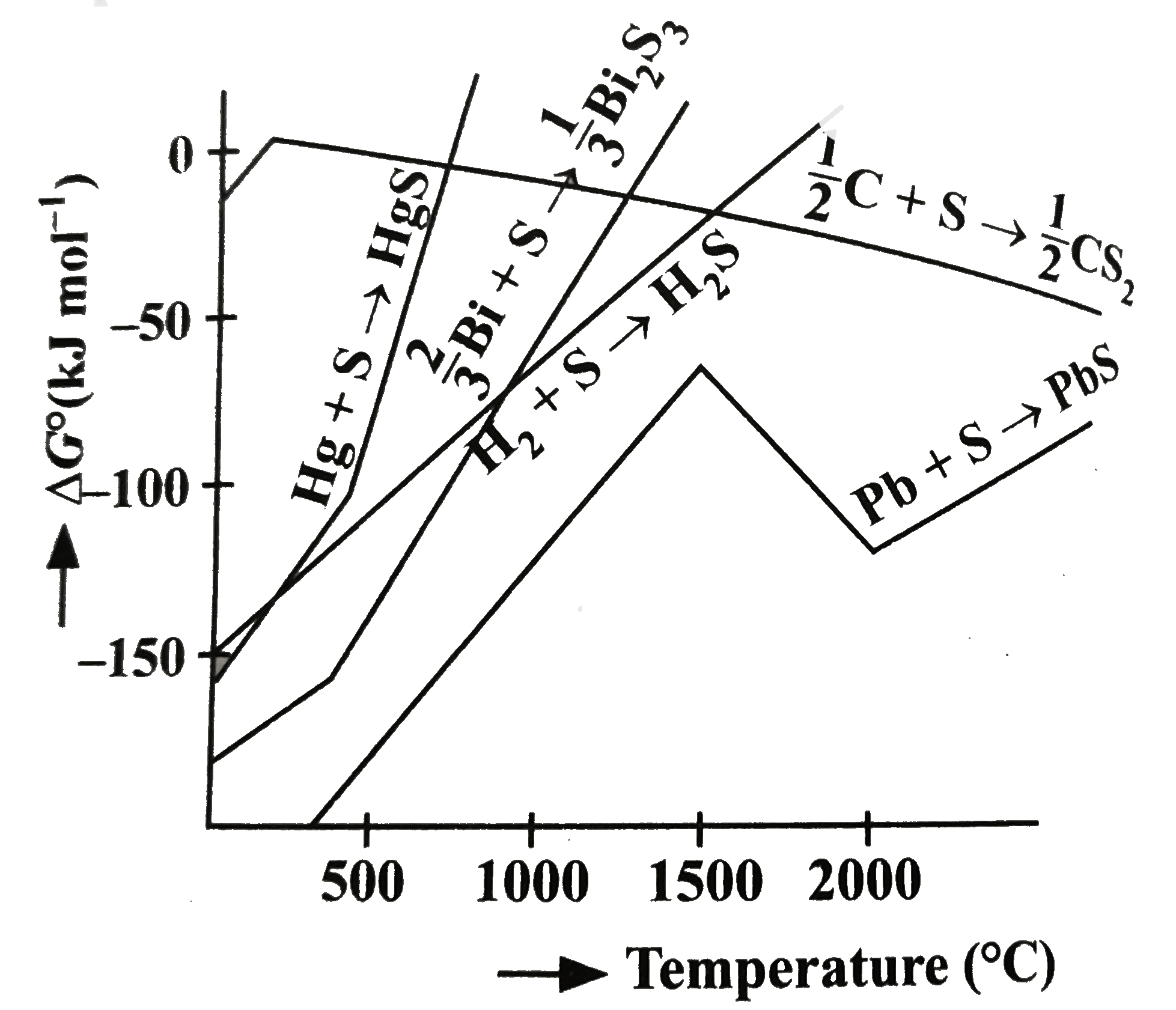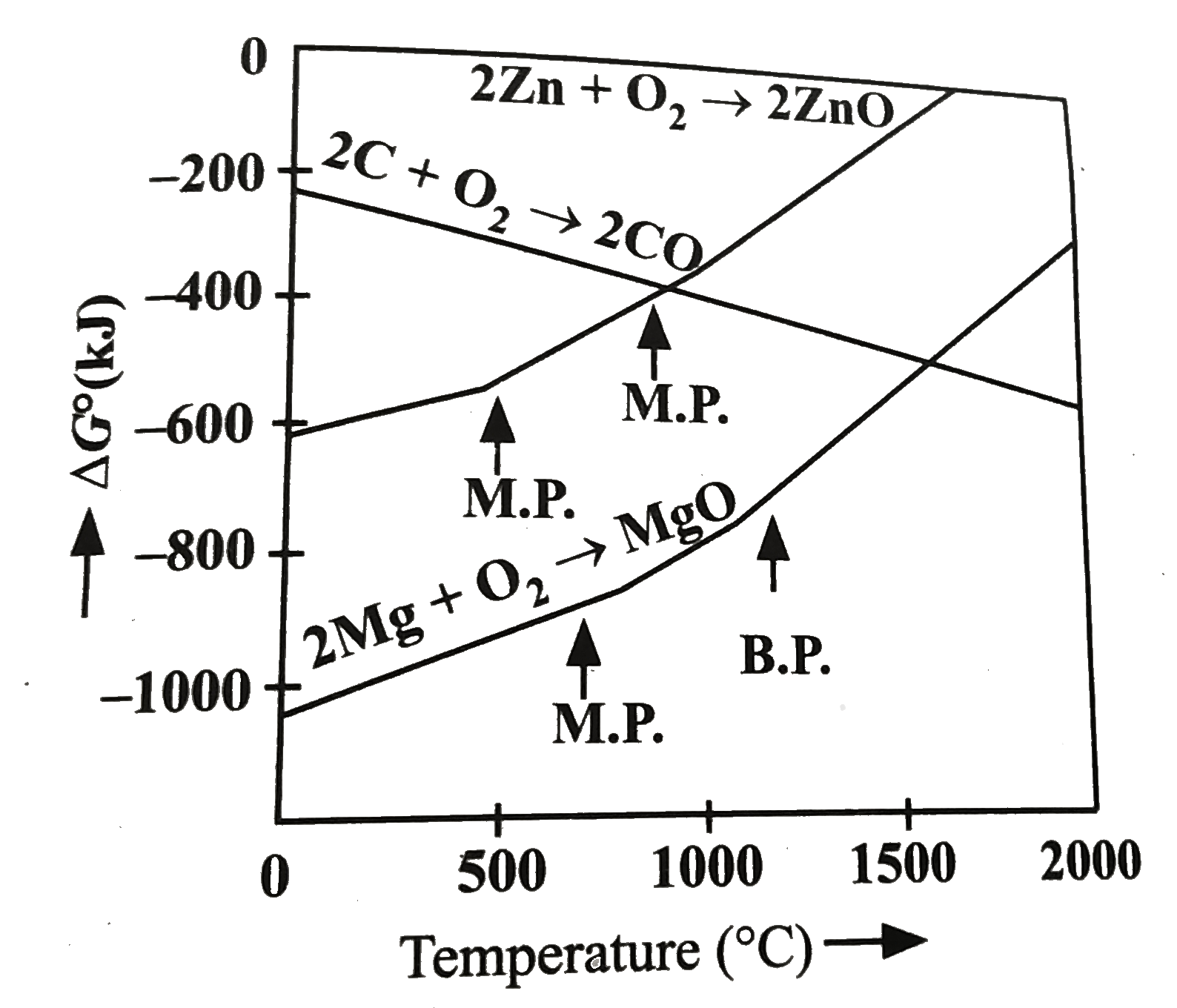Complete Solutions to Solved Example of chapter GENERAL PRINCIPLES AND PROCESS OF ISOLATION OF ELEMENTS of Class 12 book with complete answers and questions
| Class 12 | CHEMISTRY |
| Chapter | GENERAL PRINCIPLES AND PROCESS OF ISOLATION OF ELEMENTS |
| CENGAGE CHEMISTRY | Solved Example |
| Number Of Questions | 25 |
| Academic Year | 2023-24 |
Why is it advantageous to roast a sulphide ore to the oxide before reduction ?
01:10View SolutionThe extraction of `Au` by leaching with `NaCN` both oxidation and reduction. Justify giving equations.
02:12View SolutionFree energies of formation `(Delta_(f) G^(Ө))` of `MgO(s)` and `CO_((g))` at `1273 K` and `2273 K` are given below :
`Delta_(f) G^(Ө) (MgO_((s) )) = -941 kJ//mol at 1273 K`
`Delta_(f) G^(Ө) (MeO_((s))) = -314 kJ//mol at 2273 K`
`Delta_(f) G^(Ө) (CO_((g))) = - 439 kJ//mol at at 1273 K`
`Delta_(f) G^(Ө) (CO_((g))) = -628 kJ//mol at 2273 K`
On the basis of above data, predict the temperature at which carbon can be used as a reducing for agent `MgO_((s))`.02:54View SolutionGive reason : Reduction of `Cr_(2) O_(3)` with `Al` is thermodynamically feasible, yet it does no occur at room temperature.
01:44View SolutionCinnabar `(HgS)` and galena `(PbS)` on roasting often give their respective metals, but zinc blende `(ZnS)` does not. Give reason.
01:39View SolutionFrom the following flowsheet for the extraction of pure metal, answer the given questions.

(i) Step `A` is :02:00View SolutionFrom the following flowsheet for the extraction of pure metal, answer the given questions.

(ii) Step `B` (reduction) can be carried out ny using :02:18View SolutionFrom the following flowsheet for the extraction of pure metal, answer the given questions.

(iii) Impure `Cu` metal is also obtained :02:29View SolutionFrom the following flowsheet for the extraction of pure metal, answer the given questions.

(iv) Some of the following metals are obtained by electrolysis of their fused salts : `Al, Na, Cu, Ag, Mg, Ca`. These metals are :03:44View SolutionFrom the following flowsheet for the extraction of pure metal, answer the given questions.

(v) Reduction of oxides to elements with carbon generally takes place at high temperature, hence `Al` is used in aluminothermite process. It is because :03:27View SolutionFrom the following flowsheet for the extraction of pure metal, answer the given questions.

(vi) following reaction is not involved intermite process :01:48View SolutionThe Ellingham diagram for a number of metallic sulphides is reproduced below.

Answer the questions given below :
(i) Formation of which of the sulphidesis not spontaneous ?01:43View SolutionThe Ellingham diagram for a number of metallic sulphides is reproduced below.

Answer the questions given below :
(ii) Which occurs to minimum extent in nature ?01:50View SolutionThe Ellingham diagram for a number of metallic sulphides is reproduced below.

Answer the questions given below :
(iii) Which of the following sulphides can be reducted to metal by `H_(2)` at about `1000 K` ?01:48View SolutionQuestions given below are based on the given diagram for extractive metallurgy.
(i) At what approximate temperature, zinc and carbon have equal affinity for oxygen ?01:07View SolutionQuestions given below are based on the given diagram for extractive metallurgy.
(ii) At this temperature `Delta_(f) G^(Ө)` of the reaction is
`ZnO + C rarr Zn + CO`.
 .01:01View Solution
.01:01View SolutionQuestions given below are based on the given diagram for extractive metallurgy.
(iii) The make the following process spontaneous, temperature should be :
`ZnO + C rarr Zn + CO`.01:16View SolutionQuestions given below are based on the given diagram for extractive metallurgy.
(iv) At `1100^@C`, which reaction is spontaneous to a maximum extent ?01:27View SolutionQuestions given below are based on the given diagram for extractive metallurgy.
(v) This method is known as :01:12View SolutionAt high temperature, carbon reacts with water to produce a mixture of `CO` and `H_(2)`.
`C + H_(2) O overset ("Heat heat")rarr CO + H_(2)`
`CO` is separated from `H_(2)` and then used to separate `Ni` from `CO` by forming a volatile compound, nickel tetracarbonyl `(Ni(CO)_(4))`.
`Ni + 4CO rarr Ni(CO)_(4)`
(a) Formation of volatile `Ni(CO)_(4)` and its subsequent heating give pure `Ni`. Name the process involved.
(b) How many moles of `Ni(CO)_(4)` could be obtained from `CO` produced by the reaction of `75.0 g` is carbon ?04:13View Solution`A overset("Calcination")rarr CaO + MgO + underset("Colourless gas")((B))`
When the colourless gas `(B)` is passed through lime water, initially a milky solution is obtained and on excess passage of gas `(B)` through the lime water, milkiness disappears.
`(A)` is :01:57View Solution`A overset("Calcination")rarr CaO + MgO + underset("Colourless gas")((B))`
When the colourless gas `(B)` is passed through lime water, initially a milky solution is obtained and on excess passage of gas `(B)` through the lime water, milkiness disappears.
`(B)` is.01:39View Solution`A overset("Calcination")rarr CaO + MgO + underset("Colourless gas")((B))`
When the colourless gas `(B)` is passed through lime water, initially a milky solution is obtained and on excess passage of gas `(B)` through the lime water, milkiness disappears.
Name of the product `(A)` is :01:42View Solution`A overset("Calcination")rarr CaO + MgO + underset("Colourless gas")((B))`
When the colourless gas `(B)` is passed through lime water, initially a milky solution is obtained and on excess passage of gas `(B)` through the lime water, milkiness disappears.
Lime water is.01:54View Solution`A overset("Calcination")rarr CaO + MgO + underset("Colourless gas")((B))`
When the colourless gas `(B)` is passed through lime water, initially a milky solution is obtained and on excess passage of gas `(B)` through the lime water, milkiness disappears.
Milkiness of lime water solution disappears due to the formation of :01:57View Solution
Solved Example questions and complete solutions for chapter GENERAL PRINCIPLES AND PROCESS OF ISOLATION OF ELEMENTS of CENGAGE CHEMISTRY (HINGLISH) of Class 12
All Exercises from CENGAGE CHEMISTRY Class 12 CHEMISTRY GENERAL PRINCIPLES AND PROCESS OF ISOLATION OF ELEMENTS
- Archives (Fill In The Blanks)
- Archives (Linked Comprehension)
- Archives (Multiple Correct)
- Archives (Single Correct)
- Archives (Subjective)
- Exercise (Assertion-Reasoning)
- Exercise (Fill In The Blanks)
- Exercise (Integer)
- Exercise (Multiple Correct)
- Exercise (Single Correcttype)
- Exercise (True/False)
- Exercises (Linked Comprehension)
- Exs 1.1 (Objective)
- Exs 1.1 (Subjective)
- Exs 1.1 (True Orfalse Statement)
- Illustration
- Solved Example
